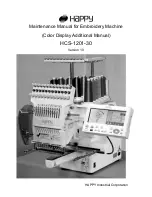
KNOWING YOUR SEWING MACHINE
—————————————————————————————————————————
32
3
You need to sew the front bar tack first. Line
the bar tack mark under the center of the
presser foot and align it with the two lines on
the presser foot.
1
Front of chalk mark
2
Red lines
■
Making A Buttonhole
■
Securing the Stitching and Cutting the
Buttonhole
1
To secure the stitching, turn the material 90
degrees counterclockwise and sew straight
stitches to the end of the front bar tack of the
buttonhole.
2
Remove the material from the machine. We
recommend that you put pins across both
ends of the buttonhole to prevent the stitches
from being cut.
3
Cut an opening in the middle of the
buttonhole with a seam ripper. Be careful not
to cut through any stitches.
●
If the presser foot is not installed with the
correct orientation, the needle may strike
the presser foot, bending or breaking the
needle and causing injuries.
Step
Sewn section
Pattern
Step 1
(Front bar tack)
1. Set the pattern selection dial to “a”.
2. Lower the presser foot and sew 5 to 6 stitches.
3. Stop the machine when the needle is at the left
side of the stitches, and then raise the needle
from the material.
Step 2
(Left side)
1. Turn the pattern selection dial to “b”.
2. Sew the predetermined length of the tailor's
chalk line.
3. Stop the machine when the needle is at the left
side of the stitch, and then raise the needle.
Step 3
(Back bar tack)
1. Turn the pattern selection dial to “c” (same
position as in step 1).
2. Sew 5 to 6 stitches.
3. Stop the machine when the needle is at the right
side of the stitch, and then raise the needle from
the material.
Step 4
(Right side)
1. Set the pattern selection dial to “d”.
2. Sew the right side until the needle reaches the
stitches sewn in step 1.
1
2
CAUTION
a
a/c
a
c
b
b
c
a/c
a
c
d
d
●
When using the seam ripper to open the
buttonhole, do not put your hand or
fingers in the path of the ripper. The seam
ripper may slip and cause injuries.
CAUTION
Summary of Contents for XL 5500 - 42 Stitch Sewing Machine
Page 1: ...Operation Manual ...














































